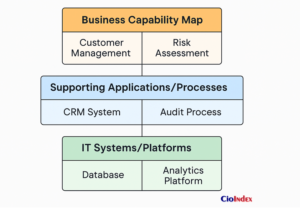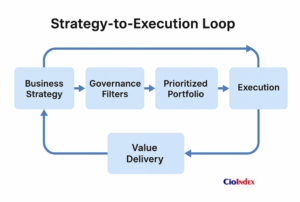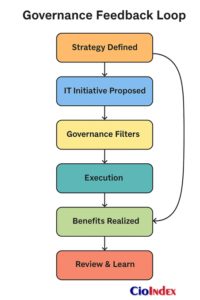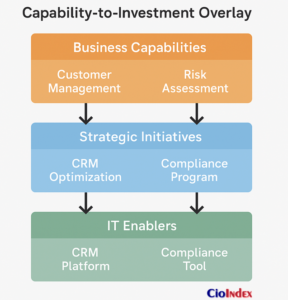Introduction: Why Strategic Alignment Is the Core Promise of IT Governance
IT doesn’t exist to be aligned. It exists to deliver. Alignment is just the mechanism that ensures it delivers the right things, at the right time, for the right reasons.
The problem? That mechanism is often broken.
Strategy says one thing; execution does another. Portfolios fill with technically sound projects that are strategically tone-deaf. Agile teams race ahead while business units drift behind. Steering committees become traffic circles. And somewhere between the board’s ambitions and the backlog’s reality, value gets lost in translation.
This is where IT governance proves its worth—not as an administrative burden, but as the connective tissue between business vision and IT execution. It’s how strategy becomes something more than a PowerPoint. It’s how operating models get realigned without guesswork. It’s how transformation efforts avoid turning into expensive misadventures.
This article goes beyond the platitudes of “alignment” and cuts to the architecture that actually enables it: demand governance, portfolio filtering, benefit realization, and the hard questions that good governance forces every technology investment to answer. Not “can we build it?”—but “should we?” And more importantly, “will it matter?”
Governance Mechanisms Table
Strategic alignment is the primary reason IT governance exists. Without it, your technology function isn’t a strategic asset — it’s just a spending category.
The Role of IT Governance in Strategic Alignment
Alignment isn’t magic. It’s engineered.
Behind every IT organization that consistently delivers business value, there’s a set of invisible structures doing visible work. Not Gantt charts or status reports — but governance mechanisms that ensure strategy isn’t just communicated, it’s operationalized. This is the real value of IT governance: it institutionalizes alignment, so it doesn’t depend on heroics, memory, or guesswork.
Governance plays this role in three ways: by defining who makes decisions, how those decisions are made, and what gets prioritized as a result. And the closer those decisions are to enterprise goals, the tighter the alignment.
Steering Committees: Where Strategy Meets Selection
Most IT portfolios die of suffocation, not sabotage. Too many priorities, too little oxygen. Steering committees solve that by turning business strategy into an investment filter — a mechanism that asks not just “Is this feasible?” but “Is this meaningful?”
The best committees aren’t internal IT review boards dressed up as cross-functional teams. They are true decision-making bodies with representatives from business, finance, compliance, and technology. Their job isn’t just to approve — it’s to align. That means killing projects that don’t support enterprise goals, reshuffling budgets to match shifting priorities, and forcing clarity on what “value” actually means.
Demand Governance: The Gate Before the Gate
Ideas are cheap. Execution isn’t. Demand governance ensures that only the ideas with strategic relevance make it past the starting line.
This mechanism screens requests against business drivers, risk appetite, resource availability, and strategic alignment — before architecture is reviewed or funding is allocated. It separates innovation from distraction. More importantly, it creates a shared language for evaluating opportunity cost, so IT doesn’t become a dumping ground for orphaned business wishlists.
Portfolio Management: Balancing Value, Risk, and Capacity
Even aligned initiatives can fail without active portfolio governance. Alignment isn’t a one-time checkpoint — it’s a continuous balancing act.
Effective portfolio governance tracks not just what is being worked on, but why — and what else isn’t. It surfaces tradeoffs. It forces prioritization. It asks whether the cumulative impact of all IT activity reflects the organization’s stated strategic direction — or if it’s just a bunch of siloed wins adding up to a strategic miss.
When done right, portfolio governance becomes a real-time feedback loop — one that prevents drift, aligns execution with strategic themes, and enables senior leaders to make informed, accountable choices about direction, spend, and timing.
Architecture Governance: Guardrails for Strategic Integrity
Sometimes the fastest path to delivery is also the fastest way to create technical debt. Architecture governance exists to ensure that solution design and technology choices don’t undermine strategic consistency.
It’s not about dictating technology. It’s about protecting cohesion — ensuring that new systems support enterprise capabilities, adhere to target-state models, and integrate in ways that don’t compromise resilience or agility. Architecture governance ensures that innovation isn’t bought at the cost of fragmentation.
Governance Mechanisms Table
| Governance Mechanism | Primary Function | Alignment Role |
| Steering Committee | Prioritization & Oversight | Aligns funding and scope to strategic goals |
| Demand Management | Intake & Filtering | Screens for relevance and business justification |
| Architecture Governance | Technical Design Review | Ensures coherence with long-term strategic models |
| Portfolio Management | Balance and Tracking | Maintains cumulative alignment across initiatives |
| Benefits Realization | Post-Project Review | Validates actual impact against original intent |
Strategic alignment isn’t an outcome you can assume — it’s a discipline you design. IT governance delivers that discipline by making alignment a requirement, not a coincidence.
Embedding Strategic Priorities into Governance Structures
Strategy isn’t self-executing. It needs structure. And not the kind that shows up in year-end planning decks — the kind embedded into the fabric of decision-making.
Too often, strategic alignment is treated as a messaging exercise. The CEO outlines a bold direction, department heads nod in agreement, and IT gets a new set of buzzwords to work into project charters. But unless those strategic priorities are institutionalized — baked into how decisions are made, who makes them, and what gets funded — alignment becomes theater.
IT governance provides architecture to ensure strategy isn’t just articulated; but enforced.
Decision Rights: Alignment Begins with Authority
One of the most overlooked dimensions of strategic alignment is control. If governance is to support business strategy, then decision-making authority must reflect strategic priorities.
That means drawing clear boundaries around:
- What decisions remain within IT’s operational scope
- What decisions require joint business-IT ownership
- What decisions are escalated to enterprise-level governance bodies
When these boundaries are undefined or unevenly applied, misalignment is inevitable. IT ends up optimizing for efficiency while the business optimizes for relevance — and the gap between the two becomes visible only after value is lost.
Clarity in decision rights prevents this. It turns accountability into a design principle, not an afterthought.
Cross-Functional Governance Bodies: The Engine of Strategic Collaboration
Alignment can’t be driven from one silo. It requires shared ownership of priorities — and shared responsibility for trade-offs.
That’s why effective IT governance structures are intentionally cross-functional. They include business unit leaders, finance, legal, risk, operations, and technology stakeholders — not as advisors, but as voting members. These aren’t ceremonial seats. They’re points of accountability.
This cross-functional composition ensures:
- Business goals are properly interpreted in technology terms
- IT constraints are visible during business planning
- Risk, compliance, and financial implications are surfaced early
The result is not just better decisions — it’s faster alignment, fewer surprises, and greater trust across the organization.
Planning Cycles: Where Strategy Meets Governance
Strategic intent doesn’t stay static — and neither should governance. When IT governance structures are only plugged into annual planning processes, they become reactive. By the time new priorities emerge, the governance model is already out of sync.
Mature organizations adopt iterative governance cycles that reflect the rhythm of strategic evolution. This includes:
- Quarterly strategy reviews embedded into governance forums
- Agile governance rituals (e.g., increment-based reviews) tied to program milestones
- Dynamic roadmapping practices linked to business OKRs or capability targets
Frameworks like COBIT’s Goals Cascade or the Balanced Scorecard offer useful scaffolding for translating enterprise goals into IT objectives and governance checkpoints. But the real work lies in customization — adapting those models to the organization’s planning cadence, culture, and complexity.
Governance doesn’t align IT to the business by accident — it does so by design. And that design must reflect not just the org chart, but the strategic logic of the enterprise.
Tools and Practices That Reinforce Alignment
Strategy isn’t abstract. It’s operational. And if IT governance is to align execution with strategy, it needs more than intent — it needs instrumentation.
Too many organizations treat alignment as a one-time event: a planning workshop, a budget approval, a signed-off roadmap. But strategic alignment is a moving target, and governance must track it in motion. That requires tools — not just technology platforms, but practices, models, and measurement systems that make alignment visible, actionable, and accountable.
Below are four categories of tools that mature IT governance programs use to keep business and IT moving in the same direction.
Balanced Scorecards: Mapping Metrics to Mission
The Balanced Scorecard remains one of the most effective tools for bridging the divide between business strategy and IT performance. Not because it’s flashy, but because it forces a basic discipline: aligning what you measure with what you value.
In governance contexts, scorecards are used to:
- Link IT KPIs to strategic objectives across financial, customer, internal, and innovation domains
- Provide governance forums with multi-dimensional performance insights
- Anchor discussions around value, not just velocity or technical throughput
For example, an initiative to modernize infrastructure isn’t just measured by migration timelines. It’s also evaluated against outcomes like customer satisfaction, operational resilience, or time-to-market improvements — the things the business actually cares about.
OKRs and Strategic KPIs: Governance Through Intent
While the Balanced Scorecard provides breadth, Objectives and Key Results (OKRs) bring focus. They allow governance bodies to clarify not only what the organization is aiming for, but what evidence will confirm progress.
Effective IT governance embeds OKRs or strategic KPIs into:
- Project intake criteria
- Quarterly review cadences
- Portfolio dashboards
Done right, these metrics shift the governance conversation from delivery to impact. From “Did we hit the timeline?” to “Did we move the needle?”
Governance becomes the enabler of intentional performance, not just project completion.
Business Capability Models: Visualizing Strategic Enablement
If strategy is the map, business capabilities are the terrain. And unless you can see how technology investments affect that terrain, you can’t govern them with strategic precision.
Business capability models are visual tools that describe:
- What the business does (capabilities)
- Where those capabilities reside (functions, units, processes)
- How they’re supported (systems, data, and architecture)
Governance bodies use these models to:
- Identify gaps in strategic enablement
- Prioritize investments based on business impact zones
- Align architecture decisions with long-term capability evolution
This is where governance steps out of the realm of checklists and into the realm of strategic design.
Benefits Realization Tracking: The Post-Delivery Truth
Too often, the governance process ends when the project is delivered. But strategic alignment doesn’t stop at go-live — it’s only validated over time.
Benefits realization tracking ensures:
- Project outcomes are assessed after deployment, not assumed
- Business owners remain accountable for realizing strategic impact
- Governance forums revisit approved initiatives to validate their contribution
This turns governance into a closed-loop system. It builds institutional memory, improves forecasting, and reinforces a culture where value, not activity, is the finish line.
Collaborative Planning Practices and Tooling
Governance alignment isn’t just about measurement — it’s about participation. That’s why forward-looking organizations use collaborative planning practices and tools to co-create roadmaps across IT and business functions.
Examples include:
- Strategic planning workshops that bring business and IT leaders together to model capability gaps and prioritize initiatives
- Roadmapping platforms (e.g., Aha!, Planview, LeanIX) that support continuous alignment with visual, accessible dashboards
- Integration with enterprise architecture tools to evaluate solution impact across capabilities and systems
These tools don’t replace governance — they amplify it. They turn alignment from a planning phase into a living practice.
Alignment is not an aspiration — it’s an engineered reality. Tools like scorecards, capability models, and benefit reviews give governance the precision it needs to ensure every initiative doesn’t just deliver — it delivers what matters.
What Good Alignment-Driven IT Governance Looks Like
Alignment isn’t a philosophy — it’s a pattern. And when IT governance is doing its job, that pattern shows up not in slogans, but in systems, structures, and results.
In well-governed organizations, alignment doesn’t require firefighting or executive interventions. It shows up quietly in how funding flows, how priorities shift, how projects get greenlit — and how few of them need rescuing. The signals are subtle, but they’re measurable. And the difference they make is profound.
What follows is not a checklist for compliance. It’s a portrait of maturity — a view into what alignment looks like when it moves from aspiration to operating principle.
Portfolios That Map Directly to Strategic Objectives
The project portfolio is not a list of IT requests in aligned organizations — it’s a manifestation of business strategy.
Each initiative is traceable to a business goal, capability uplift, or customer value outcome. There’s a clear rationale for why it’s in the portfolio, how it supports strategic themes, and what success looks like beyond delivery metrics. There are no “pet projects” or orphan initiatives with weak business cases.
Governance bodies use this visibility to:
- Evaluate the shape of the portfolio across strategic dimensions
- Adjust resource allocations based on emerging priorities
- Spot and retire initiatives that no longer contribute value
Alignment isn’t just individual — it’s cumulative.
Governance Bodies with Active Business Participation
Alignment doesn’t happen to the business — it happens with it.
In mature organizations, IT governance bodies are not IT-only forums. They’re decision platforms where business, finance, legal, risk, and IT leaders share accountability for prioritization, funding, and oversight.
That cross-functional presence ensures:
- Business context guides technology decisions
- Technology constraints inform business planning
- Trade-offs are debated in real time, not escalated after the fact
This is governance as collaboration, not ceremony.
Approval Based on Strategic Contribution, Not Technical Cool Factor
In an aligned environment, solutions don’t get approved because they’re impressive — they get approved because they’re relevant.
Strategic contribution becomes the primary approval filter, evaluated through:
- Business case rigor
- Capability impact analysis
- Alignment with enterprise goals or transformation initiatives
That doesn’t mean innovation is stifled. It means innovation is directed — toward business outcomes, not technological novelty.
Metrics That Show Both Delivery and Value Impact
You can’t govern what you can’t measure. But measurement isn’t the end — it’s the means.
Good alignment-driven governance distinguishes between:
- Delivery metrics (e.g., on-time, on-budget, velocity)
- Impact metrics (e.g., revenue uplift, cost avoidance, customer retention)
Governance frameworks incorporate both. This dual lens enables better decision-making, more credible business engagement, and a clearer understanding of what “value” really means in context.
Transparent Decision Rights and Funding Tied to Value Streams
Mature governance doesn’t operate in the shadows. It defines:
- Who decides what — and why
- How funding flows — and based on what logic
That often means shifting from project-based funding to value stream–based investment models, where money follows outcomes, not departments.
The result? More fluid prioritization. More strategic flexibility. And less governance theater.
Real-World Practices That Reinforce Alignment
Alignment isn’t conceptual — it’s built into the rhythm of operations. Leading organizations use practices like:
- Quarterly strategy reviews embedded in governance cycles
- A “Benefits Review Board” that validates ROI post-implementation
- Capability models used in every major intake or prioritization session
- Continuous backlog refinement based on changing business objectives
These aren’t best practices for the sake of optics. They’re alignment instruments — and they keep strategy and execution in sync even when both are evolving.
Strategic alignment isn’t a function of effort — it’s a function of design. In high-performing organizations, governance becomes the system through which strategy is translated into action, and action into outcomes.
When Alignment Fails: Common Governance Gaps
Misalignment doesn’t announce itself. It creeps in quietly — through a dozen plausible decisions, a handful of unnoticed trade-offs, and a governance model that’s busy managing process but blind to purpose.
By the time the warning signs become visible — failed initiatives, executive frustration, inconsistent priorities — the damage is already underway. Budgets have been consumed. Momentum has been lost. And worst of all, trust in IT as a strategic partner begins to erode.
Understanding where and how alignment fails is as important as understanding how it succeeds. Because governance isn’t just a structure — it’s a system. And like any system, it degrades when feedback loops are broken, roles are unclear, or incentives are misaligned.
Here are the most common fault lines where governance fails to support strategic alignment.
Siloed IT Decision-Making with No Business Context
IT cannot align to strategy it doesn’t see. Yet in many organizations, governance processes remain largely internal to IT — disconnected from real business input.
This results in:
- Projects that optimize systems, not outcomes
- Resource allocations based on technical feasibility, not business priority
- Solutions designed without customer, market, or operational insight
Without structured business engagement, IT ends up chasing efficiency at the expense of relevance. And governance becomes an echo chamber.
Prioritization Driven by Politics, Not Purpose
In the absence of strong governance criteria, the loudest voice often wins.
This includes:
- Business units pushing through pet projects without cross-functional alignment
- Executive requests bypassing governance review
- Funding decisions influenced by short-term optics rather than strategic fit
The result is a portfolio full of scattershot initiatives, many of which are under-scoped, under-resourced, or strategically redundant. It’s not malice — it’s governance by inertia.
Compliance-Heavy Governance with No Strategic Pulse
Governance structures built purely around risk and compliance tend to enforce control — but not coherence.
These models:
- Rely heavily on checklists and audits
- Treat governance as a reporting function, not a strategic enabler
- Prioritize documentation over discussion, and process over outcomes
The danger isn’t just inefficiency — it’s irrelevance. Teams learn to “check the box” without engaging the intent. And strategic alignment becomes collateral damage.
Missing Feedback Loops and Post-Delivery Validation
Too many organizations measure project success by whether it shipped — not whether it mattered.
Without benefits realization or post-implementation review, governance bodies lack the insight needed to:
- Adjust future prioritization based on actual impact
- Hold sponsors accountable for value delivery
- Continuously improve investment logic
Alignment suffers because there’s no mechanism to correct course — or even to know when course correction is needed.
Governance Structures That Are Static in a Dynamic Environment
Business strategy evolves. Markets shift. Priorities change. But many IT governance models are locked in annual planning cadences that make adaptation cumbersome.
This leads to:
- Inflexible roadmaps disconnected from current needs
- Projects delivered on time but off-target
- Governance bodies out of sync with strategic tempo
When governance can’t adapt, alignment becomes a historical artifact — a snapshot of a strategy that no longer applies.
Scenario: A Strategic Miss in Motion
A global insurance company launches a transformation initiative to digitize customer onboarding. The project is approved based on a solid technical plan and a clear mandate from the COO.
Twelve months later, the platform is live — but the market has moved. The strategic priority is now customer retention, not acquisition. The project delivered flawlessly against outdated goals. No one questioned the change in direction because the governance body never revisited the rationale after initial approval.
The result? A technically successful project. A strategically irrelevant outcome.
Governance failures aren’t always dramatic — they’re often systemic. When alignment fails, it’s rarely because no one tried. It’s because the system wasn’t built to sense, adapt, and act on strategic intent.
Building a Maturity Model for Strategic Alignment
Alignment is not a binary state — it’s a continuum. Organizations don’t suddenly “achieve” strategic alignment; they evolve toward it. And just as with any complex capability, maturity determines consistency, resilience, and impact.
That’s why leading IT governance models emphasize alignment maturity not as an abstract goal, but as a measurable competency — one that reflects how deeply strategy is embedded in decision-making, delivery, and accountability. Whether you’re aligning at the level of individual projects or entire portfolios, maturity defines the difference between alignment that’s aspirational and alignment that’s operational.
What follows is a practical, narrative-based view of alignment maturity — not a rigid checklist, but a living model of behaviors, capabilities, and signals that separate ad hoc governance from institutionalized alignment.
Immature Governance: Alignment by Accident
In organizations at the lower end of the maturity curve, alignment is fragile and often circumstantial. Good outcomes happen — but more by exception than by design.
Common traits include:
- Ad-hoc project approvals: Initiatives are greenlit based on stakeholder enthusiasm, technical urgency, or available budget — not strategic fit.
- Lack of business case discipline: Value propositions are thin, post-facto, or missing entirely.
- Siloed planning: IT creates technology roadmaps without visibility into enterprise priorities.
- Compliance-driven governance: Focused on audit readiness, not business enablement.
- Limited post-delivery validation: Success is measured by launch, not impact.
In these environments, governance functions more as an IT gatekeeper than a strategic bridge. Priorities shift with personnel. Portfolios drift without course correction. And accountability for value delivery is diffuse, if it exists at all.
Emerging Governance: Alignment by Design, Not Default
At mid-level maturity, organizations begin to build repeatable structures that support consistent alignment. There is still variability, but there are also signals of strategic intent being operationalized through governance.
Typical indicators include:
- Defined intake and prioritization processes linked to enterprise goals
- Business participation in governance bodies, though sometimes limited to advisory roles
- Basic strategic KPIs embedded into project dashboards or scorecards
- Architecture review boards focused on capability enablement
- Post-implementation reviews occurring inconsistently but beginning to shape future decisions
These organizations are learning how to close the loop — aligning funding with outcomes, refining portfolios based on performance, and embedding feedback mechanisms into the governance cycle. The foundations are in place, even if execution is uneven.
Mature Governance: Alignment as a Default Operating State
In high-maturity organizations, strategic alignment is not an initiative. It’s how IT works.
These environments exhibit:
- Fully integrated governance bodies with joint accountability across IT, business, and finance
- Strategic roadmaps co-created across functions and updated regularly
- Dynamic prioritization mechanisms responsive to strategic shifts and external changes
- Outcome-based funding models tied to value streams or strategic themes
- Benefits realization frameworks with clear owners, tracked over time
- Enterprise capability models used to evaluate investment decisions and architectural direction
At this level, governance operates at the speed of strategy. IT investments are no longer defended — they’re expected, because the link between action and outcome is visible, measurable, and trusted.
Framing Maturity in Action: An Example Progression
| Maturity Level | Governance Characteristics | Alignment Quality | |
| Initial | 1 | Project approvals are informal; no strategic lens | Fragmented and reactive |
| Developing | 2 | Defined intake tied to goals; some cross-functional input | Intermittent and improving |
| Established | 3 | Portfolio aligned with strategy; joint business-IT accountability | Consistent, measured, and responsive |
| Optimizing | 4 | Real-time alignment through OKRs, value tracking, and continuous feedback | Embedded, adaptive, and strategic |
Frameworks and References to Support Maturity Modeling
While your maturity model should be tailored to your organization’s structure and context, several industry frameworks offer scaffolding:
- COBIT Performance Management (CPM): Offers maturity indicators tied to alignment goals and design factors.
- CMMI Governance Process Area: Defines process institutionalization, measurement, and governance practices.
- Gartner IT Score / Forrester Maturity Models: Provide benchmarking tools and capability assessments.
The value lies not in rigid adherence to one model, but in using them to ask better questions: Are we making governance decisions at the right level? Are those decisions driving measurable results? Are we getting better at this quarter by quarter?
Strategic alignment is not a switch you flip — it’s a capability you build. Maturity in IT governance is what separates intent from impact, and consistency from chaos.
Next Steps: How CIOs and IT Leaders Can Lead Strategic Alignment
Governance isn’t a framework to implement. It’s a function to lead. And no one sits closer to that responsibility than the CIO.
While alignment must be institutionalized to endure, it almost always begins with leadership — the kind that’s willing to ask uncomfortable questions, challenge established routines, and reframe IT not as an internal service provider, but as a strategic execution partner.
This section is not a how-to guide. It’s a call to leadership — especially for those in senior IT roles tasked with not just delivering technology; but delivering value.
Ask the Right Questions — Relentlessly
The first step toward stronger alignment isn’t more governance — it’s more clarity. CIOs and governance leaders should continuously pressure-test the connection between IT activity and business impact.
Start with questions like:
- Are our IT investments traceable to strategic business goals?
- Do our governance bodies include decision-makers with business accountability?
- Is value delivery measured after launch — or assumed at approval?
- Are we funding work that supports outcomes, or just work that fits our structure?
- Does this initiative enable business capability or just fulfill a backlog request?
And then go further: make these questions unavoidable. Build them into project intake forms, portfolio reviews, benefit tracking dashboards — anywhere strategic misalignment tends to hide.
Establish Value Gates, Not Just Intake Forms
Most organizations have some form of project intake — but too few have value gates.
Feasibility tells you whether something can be done. Justification tells you whether it should be.
Value gates evaluate:
- Strategic contribution and alignment
- Business sponsorship and outcome ownership
- Opportunity cost across the portfolio
This isn’t about adding friction. It’s about filtering signals from noise — and ensuring governance supports purposeful execution, not passive throughput.
Bring Business into the Governance Room — and Keep Them There
Alignment doesn’t happen in IT-only forums.
If steering committees, architectural reviews, and investment boards don’t include senior business leaders, you’re governing in a vacuum. Cross-functional governance is not advisory — it’s accountability architecture.
That includes:
- Business co-chairs on steering committees
- Finance, Risk, and Ops embedded in initiative reviews
- Shared OKRs and KPIs across technology and business owners
When governance is distributed but not diluted, alignment becomes durable.
Invest in Capability Mapping and Outcome Tracking
Capability models aren’t just architecture tools — they’re strategic navigation systems. They show where the business creates value, where it’s struggling, and where IT has the most leverage.
Governance leaders should:
- Map capabilities against strategic priorities
- Use those models to prioritize initiatives
- Link technology investments to measurable business enablement
Similarly, outcome tracking — through post-implementation reviews, benefits dashboards, and ownership assignments — ensures the story doesn’t end at go-live. Value must be verified, not presumed.
Make Strategic Alignment a Standing Agenda Item
Alignment is not a kickoff activity. It’s a standing discipline.
Governance forums should include:
- Regular recalibration of project portfolios against evolving strategic goals
- Dynamic reallocation of resources as priorities shift
- Feedback from delivery teams and business units to surface disconnects
If alignment only gets discussed once a year, it will always be behind the business.
CIOs don’t just lead technology — they lead transformation. Strategic alignment lives or dies by whether IT leaders can turn business vision into a system of decisions, structures, and behaviors that produce results. Governance is the engine — but leadership is the driver.
In Conclusion
From Governance as Control to Governance as Strategy
IT governance is often misunderstood — not because it’s complex, but because it’s miscast.
In some organizations, it’s treated as a compliance obligation. In others, as a bureaucratic filter. And in far too many, it’s seen as something IT does to keep the lights on, not as a leadership function that keeps the business on course.
But when governance works — really works — it becomes the connective tissue between ambition and execution. It ensures that every IT initiative is more than a project; it’s a strategic investment. That portfolios reflect purpose. That decisions reflect direction. And that outcomes reflect intent.
This is the shift that separates mature organizations from reactive ones. Governance moves from being a mechanism of control to becoming a system of confidence. It doesn’t slow things down — it steers them forward. It doesn’t compete with agility — it channels it. It doesn’t ask IT to serve the business — it enables IT to be the business, delivering measurable, defensible, and strategic value at scale.
As CIOs and IT leaders navigate increasing complexity, economic pressure, and digital transformation fatigue, alignment isn’t a luxury — it’s a survival trait. And governance is how that alignment is achieved, sustained, and institutionalized.
Because in the end, strategy without governance is hope. And hope is not a delivery model.
For a deeper dive into operationalizing strategic alignment, explore our IT Governance Playbook — A Step-by-Step Guide to Implementing Effective IT Governance.





